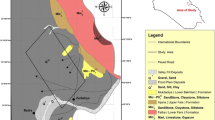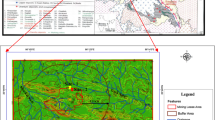Abstract
Direct current (DC) resistivity method is one of the means to explore karst areas, which has the advantages of a precise exploration target, high construction efficiency, and powerful anti-interference ability. However, the types of DC resistivity method arrays are complex, in situ exploration, different arrays are suitable for different exploration targets, which will greatly affect the construction efficiency. By generating anomaly bodies to demonstrate the various reactions of various arrays, this study compares and contrasts the benefits and drawbacks of the pole–dipole array and the Wenner array. The findings demonstrate that the Wenner array has a relatively shallow exploration depth, a reasonably good effect on surface-level anomaly identification, and a poor effect on deep-level anomaly detection; pole–dipole array has relatively large exploration depth and relatively high resolution to the deep anomalous areas. Based on this, a new data type known as multiple array data is incorporated by superimposing the data from two arrays. The following inferences are made from the inversion results: multiple array can not only retain the maximum investigation depth of single arrays, but also respond to anomalous areas better than any single arrays. Moreover, the reliability of multiple array data is further verified by an example of limestone exploration, therefore providing basis for field survey.












Similar content being viewed by others
Data availability
The datasets generated during and/or analyzed during the current study are available from the corresponding author on reasonable request.
References
Bustos J, Pasten C, Pavez D, Acevedo M, Ruiz S, Astroza R (2023) Two-dimensional simulation of the seismic response of the Santiago Basin, Chile. Soil Dyn Earthq Eng 164:107569
Caselle C, Bonetto S, Comina C, Stocco S (2020) GPR surveys for the prevention of karst risk in underground gypsum quarries. Tunn Undergr Space Technol 95:103137
Chang JH, Yu JC, Liu ZX (2016) Three-dimensional numerical modeling of full-space transient electromagnetic responses of water in goaf. Appl Geophys 13(3):539–552
Chen P, Yang T, Chen XX, Liu YJ, Chu TX (2018) Intelligent identification of gas anomalous area by electro-magnetic joint exploration technology. J Eng 16:1645–1649
Dahlin T, Zhou B (2004) A numerical comparison of 2D resistivity imaging with ten electrode arrays. Geophys Prospect 52(5):379–398
Duan CL, Yan CH, Xu BT, Zhou YK (2017) Crosshole seismic CT data field experiments and interpretation for karst caves in deep foundations. Eng Geol 228:180–196
Gao WF, Han J, Liu Y, Wang DD, Li CS (2016) Research on the forward model DC method of abnormal body in full space based on ANSYS. Prog Geophys 31(5):2089–2094 (in Chinese)
Gao WF, Liu Y, Shi LQ, Zhai PH (2019) Roof and floor anomalous response of mine resistivity method. Environ Earth Sci 78:696
Gao WF, Zhai PH, Xiao LL, Liu TH (2020) Research and application of the 3D DC resistivity method with around working face. Chin J Geophys 63(9):3534–3544
Gomez-Ortiz D, Martin-Crespo T (2012) Assessing the risk of subsidence of a sinkhole collapse using ground penetrating radar and electrical resistivity tomography. Eng Geol 149–150:1–12
Griffiths DH, Barker RD (1993) Two-dimensional resistivity imaging and modelling in areas of complex geology. J Appl Geophys 29(3–4):211–226
Gundogdu NY, Candansayar ME, Gen E (2017) Rescue archaeology application: investigation of Kuriaki Mound Archaeological area (Batman, SE Turkey) by using Directc Current Resistivity and Magnetic methods. J Environ Eng Geophys 22(2):177–189
Hoversten GM, Myer D, Key K, Alumbaugh D, Hermann O, Hobbet R (2015) Field test of sub-basalt hydrocarbon exploration with marine controlled source electromagnetic and magnetotelluric data. Geophys Prospect 63(5):1284–1310
Hu XW, Han D, Mavoungou DMN (2021) Roadway transient electromagnetic signal analysis and its testing system improvement. Explor Geophys. https://doi.org/10.1080/08123985.2021.1922276
Kaya MA, Qzurlan G, Balkaya C (2015) Geoelectrical investigation of seawater intrusion in the coastal urban area of Canakkale, NW Turkey. Environ Earth Sci 73(3):1151–1160
Li SC, Liu B, Nie LC, Liu ZY, Tian MZ, Wang SR, Su MX, Guo Q (2015) Detecting and monitoring of water inrush in tunnels and coal mines using direct current resistivity method: a review. J Rock Mech Geotech Eng 7(4):469–478
Li J, Tang JT, Xu ZM, Yan H (2017) Magnetotelluric noise suppression base on signal-to-noise identification in ore concentration area. Chin J Geophys 60(2):722–737
Li JJ, Li FJ, Hu MS, Zhou X, Hou Y (2019a) Dynamic monitoring of the mining-induced fractured zone in overburden strata, based on geo-electrical characteristics. Arab J Geosci 12(14):1–12. https://doi.org/10.1007/s12517-019-4591-x
Li MF, Liu SC, Su BY, Ma YS, Sun QL (2019b) Study on Transient Electromagnetic response of high resistivity goafs and its application. Elektronika Ir Elektrotechnika 25(1):31–35
Loke MH, Barker RD (1995) Least-squares deconvolution of apparent resistivity pseudosections. Geophysics 60:1682–1690
Loke MH, Chambers JE, Rucker DF, Kuras O, Wilkinson PB (2013) Recent developments in the direct-current geoelectrical imaging method. J Appl Geophys 95:135–156
Loke MH (2004) Tutorial: 2-D and 3-D electrical imaging surveys. http://www.geotomosoft.com. Accessed 11 Jul 2007
Minsley BJ, Burton BL, Ikard S, Powers MH (2011) Hydrogeophysical investigations at hidden dam, Raymond, California. J Environ Eng Geophys 16(4):145–164
Scott FR, Laurence RB, Diana MA (2007) Constraining aquifer architecture with electrical resistivity imaging in a fractured hydrogeological setting. J Environ Eng Geophys 12(4):323–335. https://doi.org/10.2113/JEEG12.4.323
Tsourlos P, Papadopoulos N, Papazachos C, Yi MJ, Kim JH (2014) Efficient 2D inversion of long ERT sections. J Appl Geophys 105:213–224
Xu T, Dunbar JA (2015) Binning method for mapping irregularly distributed continuous resistivity profiling data onto a regular grid for 3-D inversion. J Environ Eng Geophys 20(1):1–17
Zhou WF, Beck BF, Adams AL (2002) Effective electrode array in mapping karst hazards in electrical resistivity tomography. Environ Geol 42(8):922–928
Acknowledgements
The deepest gratitude goes to the anonymous reviewers for the careful work and insightful suggestions that have helped improve this paper substantially.
Funding
There is no funding for this work.
Author information
Authors and Affiliations
Contributions
LJ drafted the article and polished the language of the article. QZ drew all the pictures and processed the data.
Corresponding author
Ethics declarations
Conflict of interest
The authors have no conflicts of interest to declare that are relevant to the content of this article.
Additional information
Publisher's Note
Springer Nature remains neutral with regard to jurisdictional claims in published maps and institutional affiliations.
Supplementary Information
Below is the link to the electronic supplementary material.
Rights and permissions
Springer Nature or its licensor (e.g. a society or other partner) holds exclusive rights to this article under a publishing agreement with the author(s) or other rightsholder(s); author self-archiving of the accepted manuscript version of this article is solely governed by the terms of such publishing agreement and applicable law.
About this article
Cite this article
Jia, L., Zhang, Q. Application of joint inversion of Wenner and pole–dipole arrays in limestone exploration. Carbonates Evaporites 38, 61 (2023). https://doi.org/10.1007/s13146-023-00885-7
Accepted:
Published:
DOI: https://doi.org/10.1007/s13146-023-00885-7




